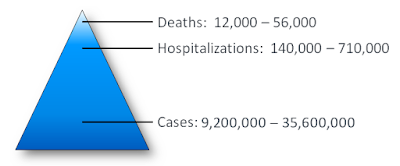
Note: This is day 4 of National Preparedness Month. Follow this year’s campaign on Twitter by searching for the #NatlPrep #BeReady or #PrepMonth hashtags.
This month, as part of NPM22, I’ll be rerunning some updated preparedness essays, along with some new ones.
#16,987
Because we live in an uncertain and sometimes dangerous world - which was true, even before 2020 rolled around - I'm a life-long proponent of being prepared to deal with the unexpected.
For this reason I devote a good deal of this blog each September to National Preparedness Month.
I keep a well stocked first aid kit in my home and car, a couple of weeks of extra food and water in the pantry, try to maintain a months worth of extra Rx meds, and have a bug out bag, a disaster plan, and a couple of `Disaster Buddies' I can call on in an emergency.
I'm far from being a `survivalist' - mainly because at my age (68), with my cholesterol, weight, and B/P - that's probably not a realistic goal. But I am a modest `prepper', and have been for my entire adult life (see NPM13: The Making Of A Prepper).
You might not have thought about it, but getting your seasonal flu shot each year should be part of your overall preparedness plan. During a disaster or prolonged emergency you are going to be tired, stressed, and your immune systems likely weakened. The last thing you need to be dealing with during a crisis is to be sick with the flu.
Granted, if I were truly committed, I'd also eat healthier, lose weight, and exercise more . . . but at this late date, I'm pretty sure that's not going to happen.
But I do get the flu shot every fall, and have now for the past 17 years. Which is why sometime in the next week or two, I'll visit my local pharmacy and get my yearly flu jab. While most years the flu shot only provides modest protection (40%-60%), I've only had the flu once since 2005.
YMMV, of course.
While we can't predict what kind of flu season lies ahead - we are coming off 2 years of suppressed flu activity due to our response to the COVID pandemic - and community immunity to seasonal influenza is believed to be low.
Other signs that the flu may return with a vengeance this fall include: Australia has just come off a very early, and robust, flu season (see Australia's Early and Impressive Flu Season), while Vietnam and much of Southern China have reported an unusually strong summer wave of H3N2.
And while nobody is quite sure how often it happens, there are also concerns over the health impacts of dual (COVID and flu) infection (see The Lancet: SARS-CoV-2 Co-infection With Influenza Viruses, RSV, or Adenoviruses).
Even by itself, influenza can be deadly. In a normal year, seasonal flu kills roughly as many Americans as does gun violence, or car accidents. In a bad year - such as we saw in 2017-2018, influenza can kill as many as both of those combined.
The evidence that influenza infection raises the risks of heart attack and/or strokes continues to grow, including:
Even when the flu shot doesn't prevent infection, there is growing evidence it can reduce the severity of one's illness, and reduce your odds of having a heart attack or stroke (see Study Suggests Flu Vaccine May Lower Stroke Risk in Elderly ICU Patients).
Although they've been available and offered without official recommendation over the standard flu shot for years, this summer - the CDC Endorsed ACIP's Recommendation On High-Dose/Adjuvanted Flu Vaccines For Seniors.
While the current flu vaccine is far from perfect, and can’t promise 100% protection, it – along with practicing good flu hygiene (washing hands, covering coughs and/or wearing a mask & staying home if sick) – remains your best strategy for avoiding the flu and staying healthy this winter.
And with our concurrent COVID pandemic, anything that can help keep you out of the hospital this fall and winter is worth doing.
And with our concurrent COVID pandemic, anything that can help keep you out of the hospital this fall and winter is worth doing.
